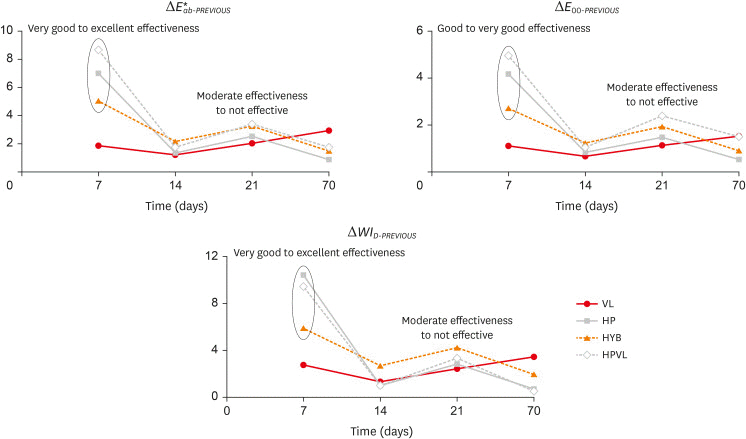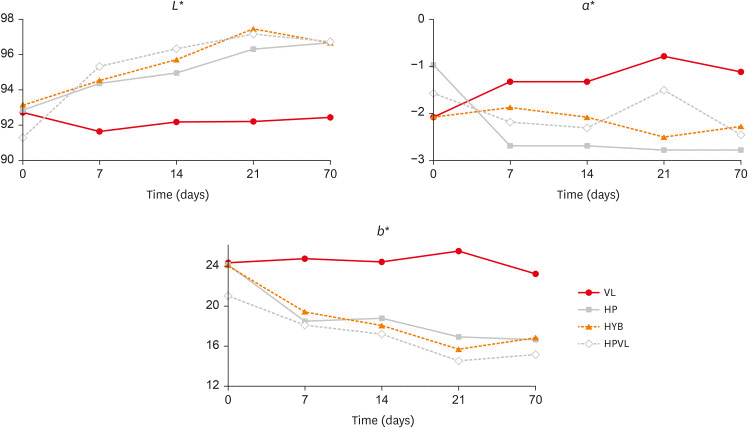Restor Dent Endod.
2022 Feb;47(1):e7. 10.5395/rde.2022.47.e7.
In-office dental bleaching with violet light emitting diode: bleaching efficacy and pulpal temperature rise
- Affiliations
-
- 1School of Health Sciences, Graduate Program in Dentistry, Universidade Positivo, Curitiba, PR, Brazil
- KMID: 2548116
- DOI: http://doi.org/10.5395/rde.2022.47.e7
Abstract
Objectives
This study evaluated the bleaching efficacy of different in-office protocols associated with violet light emitting diode (V-LED), and measured the pulpal temperature rise caused by V-LED with or without gel application.
Materials and Methods
Bovine incisors were distributed in 4 groups (n = 10): VL – V-LED; HP – 35% hydrogen peroxide (control); HYB – hybrid protocol, V-LED applied without gel for 10 irradiation cycles followed by V-LED applied with gel for another 10 irradiation cycles; and HPVL – gel and V-LED applied for 20 irradiation cycles. Three bleaching sessions were performed with 7-day intervals.Bleaching efficacy was evaluated with ΔE*ab , ΔE00 and ΔWID. Data were recorded at baseline, 7, 14, 21 and 70 days. For pulpal temperature rise, thermocouples were placed inside the pulp chamber of human incisors. To determine intrapulpal temperature, the teeth were irradiated with V-LED with or without application of bleaching gel. Color difference data were analyzed by 2-way repeated measures ANOVA and Tukey’s test. Pulpal temperature was analyzed by t-test (α = 5%).
Results
VL exhibited lower color (ΔE*ab and ΔE00) and whiteness changes (ΔWID) than the other groups. HPVL presented higher color change values than HYB. HYB and HPVL showed not different ΔWID values; and HP showed the highest whiteness changes at all times. There were significant differences comparing ΔT with gel (8.9°C) and without gel application (7.2°C).
Conclusions
HPLV was more efficient than HYB. The 2 protocols with VL showed similar results to control. Gel application combined with VL promoted higher pulpal temperature than to the no gel group.
Figure
Reference
-
1. Sulieman M, Addy M, Rees JS. Development and evaluation of a method in vitro to study the effectiveness of tooth bleaching. J Dent. 2003; 31:415–422. PMID: 12878024.
Article2. Carlos NR, Pinto A, do Amaral F, França F, Turssi CP, Basting RT. Influence of staining solutions on color change and enamel surface properties during at-home and in-office dental bleaching: an in situ study. Oper Dent. 2019; 44:595–608. PMID: 31034349.
Article3. Grazioli G, Valente LL, Isolan CP, Pinheiro HA, Duarte CG, Münchow EA. Bleaching and enamel surface interactions resulting from the use of highly-concentrated bleaching gels. Arch Oral Biol. 2018; 87:157–162. PMID: 29304422.
Article4. Alomari Q, El Daraa E. A randomized clinical trial of in-office dental bleaching with or without light activation. J Contemp Dent Pract. 2010; 11:E017–E024.
Article5. de Geus JL, Wambier LM, Kossatz S, Loguercio AD, Reis A. At-home vs in-office bleaching: a systematic review and meta-analysis. Oper Dent. 2016; 41:341–356. PMID: 27045285.
Article6. Henry RK, Bauchmoyer SM, Moore W, Rashid RG. The effect of light on tooth whitening: a split-mouth design. Int J Dent Hyg. 2013; 11:151–154. PMID: 22783981.
Article7. Soares DG, Basso FG, Hebling J, de Souza Costa CA. Concentrations of and application protocols for hydrogen peroxide bleaching gels: effects on pulp cell viability and whitening efficacy. J Dent. 2014; 42:185–198. PMID: 24239924.
Article8. Gonçalves ML, Tavares AC, Mota AC, Penna LA, Deana AM, Bussadori SK. In-office tooth bleaching for adolescents using hydrogen peroxide-based gels: clinical trial. Braz Dent J. 2017; 28:720–725. PMID: 29211128.
Article9. Brugnera AP, Nammour S, Rodrigues JA, Mayer-Santos E, de Freitas PM, Brugnera A, Zanin F. Clinical evaluation of in-office dental bleaching using a violet light-emitted diode. Photobiomodul Photomed Laser Surg. 2020; 38:98–104. PMID: 31436475.
Article10. Gallinari MO, Cintra LT, Souza MB, Barboza AC, Esteves LM, Fagundes TC, Briso AL. Clinical analysis of color change and tooth sensitivity to violet LED during bleaching treatment: a case series with split-mouth design. Photodiagnosis Photodyn Ther. 2019; 27:59–65. PMID: 31121330.
Article11. Gallinari MO, Fagundes TC, da Silva LM, de Almeida Souza MB, Barboza A, Briso A. A new approach for dental bleaching using violet light with or without the use of whitening gel: study of bleaching effectiveness. Oper Dent. 2019; 44:521–529. PMID: 31021692.
Article12. Maran BM, Ziegelmann PK, Burey A, de Paris Matos T, Loguercio AD, Reis A. Different light-activation systems associated with dental bleaching: a systematic review and a network meta-analysis. Clin Oral Investig. 2019; 23:1499–1512.
Article13. Joiner A. The bleaching of teeth: a review of the literature. J Dent. 2006; 34:412–419. PMID: 16569473.
Article14. Kossatz S, Dalanhol AP, Cunha T, Loguercio A, Reis A. Effect of light activation on tooth sensitivity after in-office bleaching. Oper Dent. 2011; 36:251–257. PMID: 21740236.
Article15. Luk K, Tam L, Hubert M. Effect of light energy on peroxide tooth bleaching. J Am Dent Assoc. 2004; 135:194–201. PMID: 15005435.
Article16. Kury M, Wada EE, Silva DP, Tabchoury CP, Giannini M, Cavalli V. Effect of violet LED light on in-office bleaching protocols: a randomized controlled clinical trial. J Appl Oral Sci. 2020; 28:e20190720. PMID: 32428059.
Article17. Silva Daltro TW, Gomes de Almeida SA, Dias MF, Lins-Filho PC, da Silva CH, Guimarães RP. The influence of violet LED light on tooth bleaching protocols: in vitro study of bleaching effectiveness. Photodiagnosis Photodyn Ther. 2020; 32:102052. PMID: 33059108.18. Kury M, Perches C, da Silva DP, André CB, Tabchoury CP, Giannini M, Cavalli V. Color change, diffusion of hydrogen peroxide, and enamel morphology after in-office bleaching with violet light or nonthermal atmospheric plasma: an in vitro study. J Esthet Restor Dent. 2020; 32:102–112. PMID: 31845449.
Article19. Costacurta AO, Borges CE, Centenaro C, Correr GM, Kaizer MR, Gonzaga CC. The bleaching efficacy of carbamide peroxide gels containing potassium nitrate desensitizer. J Clin Exp Dent. 2020; 12:e644–e649. PMID: 32905070.
Article20. Kwon SR, Cortez E, Wang M, Jagwani M, Oyoyo U, Li Y. Systematic review of in vitro studies evaluating tooth bleaching efficacy. Am J Dent. 2020; 33:17–24. PMID: 32056410.21. Commission Internationale de l'Eclairage (CIE). CIE technical report: colorimetry. CIE Pub No. 15.3. Vienna: CIE Central Bureau;2004.22. Paravina RD, Ghinea R, Herrera LJ, Bona AD, Igiel C, Linninger M, Sakai M, Takahashi H, Tashkandi E, Perez MM. Color difference thresholds in dentistry. J Esthet Restor Dent. 2015; 27(Supplment 1):S1–S9. PMID: 25886208.
Article23. Pérez MM, Ghinea R, Rivas MJ, Yebra A, Ionescu AM, Paravina RD, Herrera LJ. Development of a customized whiteness index for dentistry based on CIELAB color space. Dent Mater. 2016; 32:461–467. PMID: 26778404.
Article24. Paravina RD, Pérez MM, Ghinea R. Acceptability and perceptibility thresholds in dentistry: a comprehensive review of clinical and research applications. J Esthet Restor Dent. 2019; 31:103–112. PMID: 30891913.
Article25. Salem YM, Osman YI. The effect of in-office vital bleaching and patient perception of the shade change. SADJ. 2011; 66:7072–76. PMID: 21608500.26. Pérez MM, Herrera LJ, Carrillo F, Pecho OE, Dudea D, Gasparik C, Ghinea R, Bona AD. Whiteness difference thresholds in dentistry. Dent Mater. 2019; 35:292–297. PMID: 30527588.
Article27. Pimenta-Dutra AC, Albuquerque RC, Morgan LS, Pereira GM, Nunes E, Horta MC, Silveira FF. Effect of bleaching agents on enamel surface of bovine teeth: a SEM study. J Clin Exp Dent. 2017; 9:e46–e50. PMID: 28149462.
Article28. Wiegand A, Vollmer D, Foitzik M, Attin R, Attin T. Efficacy of different whitening modalities on bovine enamel and dentin. Clin Oral Investig. 2005; 9:91–97.
Article29. de Carvalho AC, de Souza TF, Liporoni PC, Pizi EC, Matuda LA, Catelan A. Effect of bleaching agents on hardness, surface roughness and color parameters of dental enamel. J Clin Exp Dent. 2020; 12:e670–e675. PMID: 32905007.
Article30. Ito Y, Otsuki M, Tagami J. Effect of pH conditioners on tooth bleaching. Clin Exp Dent Res. 2019; 5:212–218. PMID: 31249701.
Article31. Zach L, Cohen G. Pulp response to externally applied heat. Oral Surg Oral Med Oral Pathol. 1965; 19:515–530. PMID: 14263662.
Article32. Eriksson A, Albrektsson T, Grane B, McQueen D. Thermal injury to bone. A vital-microscopic description of heat effects. Int J Oral Surg. 1982; 11:115–121. PMID: 6809671.33. Baldissara P, Catapano S, Scotti R. Clinical and histological evaluation of thermal injury thresholds in human teeth: a preliminary study. J Oral Rehabil. 1997; 24:791–801. PMID: 9426160.
Article34. Sulieman M, Rees JS, Addy M. Surface and pulp chamber temperature rises during tooth bleaching using a diode laser: a study in vitro . Br Dent J. 2006; 200:631–634. PMID: 16767142.
Article35. Baik JW, Rueggeberg FA, Liewehr FR. Effect of light-enhanced bleaching on in vitro surface and intrapulpal temperature rise. J Esthet Restor Dent. 2001; 13:370–378. PMID: 11778856.
Article
- Full Text Links
- Actions
-
Cited
- CITED
-
- Close
- Share
- Similar articles
-
- Can carbamide peroxide be as effective as hydrogen peroxide for in-office tooth bleaching and cause less sensitivity? A systematic review
- The effectiveness of sealing technique on in-office bleaching
- Clinical assessment of whitening efficacy and safety of in-office tooth whitening system containing 15% hydrogen peroxide with or without light activation
- Does the time interval after bleaching influence the adhesion of orthodontic brackets?
- Effect of post-bleaching time intervals on resin in dentin bonding strength




